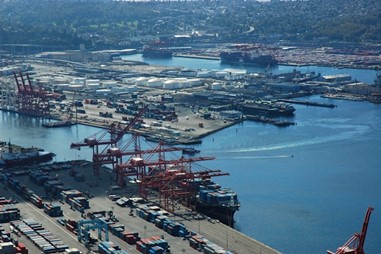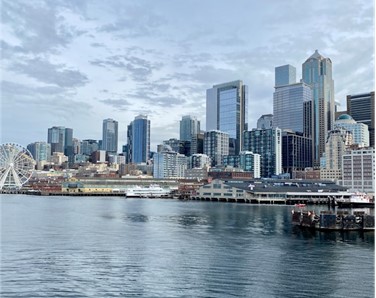
Ryan Calkins is the Port of Seattle Commissioner and is focused on sustainable economic development to ensure the region's prosperity is shared among all of the surrounding communities. Ryan balances immediate Port needs with a long-term vision, ensuring the region's most valuable public assets will continue to thrive for generations to come. In the following article, he discusses how the Port of Seattle has embraced Washington Maritime Blue, an ambitious initiative aimed at transforming the maritime sector through innovative and eco-friendly solutions.
The maritime industry, a cornerstone of global commerce, faces significant environmental challenges. Traditional practices have often led to substantial carbon emissions, ocean pollution, and ecological disruption. In response, this collaborative initiative has emerged to advance sustainable practices within the sector. Centered at the Port of Seattle, this enterprise exemplifies how coordinated efforts can transform industries and foster environmental stewardship.
Ryan Calkins Highlights the Genesis of Washington Maritime Blue
Washington Maritime Blue is a strategic alliance established to enhance maritime sustainability. It was launched as part of the broader Washington State Governor’s Maritime Innovation Advisory Council’s efforts. The council, recognizing the pressing need for eco-friendly nautical operations, sought to create a framework that would drive innovation, collaboration, and sustainable economic growth within the sector.
The Port of Seattle, one of the
busiest ports on the West Coast, serves as a focal point for Washington Maritime Blue’s initiatives. The strategic location and significant volume of trade at the port make it an ideal platform for implementing and demonstrating sustainable maritime practices.
Core Objectives and Strategies
Ryan Calkins, Port of Seattle explains that the organization operates on a multi-faceted approach designed to address various aspects of maritime sustainability. The initiative’s core objectives include:
- Reducing Carbon Emissions: One of the primary goals is to cut down greenhouse gas emissions from maritime operations. This involves promoting the use of alternative fuels, electrification of port facilities, and encouraging energy-efficient vessel designs.
- Innovating Green Technologies: The initiative also supports research and development of new technologies aimed at minimizing the environmental footprint of maritime activities. This includes advancements in clean energy, waste management systems, and emission control technologies. Notably, Ryan Calkins launched the award-winning Tacoma Blue Edge Network, one of the nation’s first private 5G networks at a public port. An impressive partnership including the City of Tacoma, 5G Open Innovation Lab, Washington Maritime Blue and the Edge Cluster installed Phase 1 of the project in the Port of Tacoma. The network allows for leveraging state-of-the-art connectivity, edge computing and applications to increase efficiency, enhance worker safety and improve profitability for maritime enterprises. The network also seeks to leverage Tacoma’s long-standing maritime heritage with the technology of today and tomorrow.
- Promoting Collaboration: Recognizing that sustainability is a collective effort, Washington Maritime Blue fosters partnerships among industry stakeholders, including shipping companies, technology providers, academic institutions, and government agencies. These collaborations are pivotal in driving systemic changes and sharing best practices.
- Enhancing Economic Growth: While environmental sustainability is paramount, the initiative also aims to bolster economic development. Ryan Calkins, Port of Seattle explains that fostering a green maritime industry helps create jobs, attract investment, and position Washington State as a leader in sustainable maritime operations.
Key Projects and Initiatives
Several notable projects underscore the tangible impact of Washington Maritime Blue:

- Clean Energy and Electrification: Ryan Calkins, Port of Seattle notes that one of the standout projects is the electrification of the Port of Seattle’s terminal operations. By transitioning from diesel-powered equipment to electric alternatives, the port significantly reduces its carbon footprint. This project includes the installation of shore power systems, allowing vessels to plug into the electrical grid while docked, thereby cutting emissions from auxiliary engines.
- Hydrogen Fuel Cells for Maritime Use: In partnership with private firms and research institutions, the organization is exploring the feasibility of hydrogen fuel cells as a clean energy source for maritime vessels. Hydrogen fuel cells offer a promising alternative to conventional fossil fuels, providing a zero-emission power solution.
- Maritime Innovation Center: The establishment of the Maritime Innovation Center at Fishermen’s Terminal in Seattle serves as a hub for research, development, and collaboration. The center provides resources for startups and established companies to develop and test new technologies aimed at sustainable maritime practices.
- Waste Reduction and Management: Ryan Calkins, Port of Seattle states that the initiative is also focused on improving waste management practices at the port. This includes better handling of ship-generated waste, promoting recycling, and implementing advanced waste treatment technologies to prevent marine pollution.
- Blue Carbon Projects: Washington Maritime Blue is also involved in blue carbon projects that focus on preserving and restoring marine ecosystems such as seagrass beds and salt marshes. These ecosystems are crucial for carbon sequestration and play a vital role in mitigating climate change.
Achievements and Future Prospects
Since its inception, Washington Maritime Blue has made significant strides in advancing sustainable maritime practices. The electrification of port facilities has led to measurable reductions in greenhouse gas emissions. Collaborative research projects have resulted in technological innovations that are being adopted by local maritime operators.
Looking ahead, the initiative aims to expand its impact through several avenues:
- Scaling Up Clean Energy Solutions: There are plans to broaden the use of renewable energy sources and electrification across more port facilities and maritime operations, setting a precedent for other ports globally.
- Global Leadership and Influence: Ryan Calkins, Port of Seattle and Washington Maritime Blue aspire to position the state as a global leader in sustainable maritime practices. By sharing knowledge and best practices, the initiative seeks to influence policy and drive international standards for maritime sustainability.
- Continued Innovation and Research: Ongoing investments in research and development will be critical. The initiative plans to support emerging technologies and innovative solutions that can further reduce environmental impacts and enhance operational efficiency.
Conclusion
Ryan Calkins, Port of Seattle explains that Washington Maritime Blue represents a visionary approach to transforming the maritime industry. By focusing on sustainability, innovation, and collaboration, the initiative not only addresses the pressing environmental challenges but also paves the way for economic growth and global leadership in green maritime practices. The Port of Seattle, through its active participation and implementation of these sustainable strategies, stands as a testament to what can be achieved when industry stakeholders unite for a common cause. As the organization continues to evolve, it offers a blueprint for other ports and maritime hubs worldwide to follow, ensuring a cleaner, greener future for the maritime industry.
 Ryan Calkins is the Port of Seattle Commissioner and is focused on sustainable economic development to ensure the region's prosperity is shared among all of the surrounding communities. Ryan balances immediate Port needs with a long-term vision, ensuring the region's most valuable public assets will continue to thrive for generations to come. In the following article, he discusses how the Port of Seattle has embraced Washington Maritime Blue, an ambitious initiative aimed at transforming the maritime sector through innovative and eco-friendly solutions.
The maritime industry, a cornerstone of global commerce, faces significant environmental challenges. Traditional practices have often led to substantial carbon emissions, ocean pollution, and ecological disruption. In response, this collaborative initiative has emerged to advance sustainable practices within the sector. Centered at the Port of Seattle, this enterprise exemplifies how coordinated efforts can transform industries and foster environmental stewardship.
Ryan Calkins is the Port of Seattle Commissioner and is focused on sustainable economic development to ensure the region's prosperity is shared among all of the surrounding communities. Ryan balances immediate Port needs with a long-term vision, ensuring the region's most valuable public assets will continue to thrive for generations to come. In the following article, he discusses how the Port of Seattle has embraced Washington Maritime Blue, an ambitious initiative aimed at transforming the maritime sector through innovative and eco-friendly solutions.
The maritime industry, a cornerstone of global commerce, faces significant environmental challenges. Traditional practices have often led to substantial carbon emissions, ocean pollution, and ecological disruption. In response, this collaborative initiative has emerged to advance sustainable practices within the sector. Centered at the Port of Seattle, this enterprise exemplifies how coordinated efforts can transform industries and foster environmental stewardship.
